
- •Michelangelo buonarroti (1475 – 1564)
- •I. Practice the pronunciation of the following words and word-combinations and learn them.
- •II. Practice the pronunciation of the following (a) toponyms and (b) proper names:
- •Thomas gainsborough (1727 – 1788)
- •I. Practice the pronunciation of the following words and word-combinations and learn them.
- •II. Practice the pronunciation of the following (a) toponyms and (b) proper names:
- •John constable (1776 – 1837)
- •I. Practice the pronunciation of the following words and word-combinations and learn them.
- •II. Practice the pronunciation of the following (a) toponyms and (b) proper names:
- •The dutch school
- •I. Practice the pronunciation of the following words and word-combinations and learn them.
- •II. Practice the pronunciation of the following (a) toponyms and (b) proper names:
- •The french impressionists
I. Practice the pronunciation of the following words and word-combinations and learn them.
(to do smth) through … [θru:] – делать что-л. посредством чего-л. ещё
syn. (to do smth) by means of … ['mi:nz] / (to do smth) with the help of …
use [ju:s] – (n) использование;
to make use of smth / syn. (v) to use smth ['ju:z] / – использовать что-л.
three-dimensional ['θri: dɪ'men∫ən(ə)l] – трёхмерный
to achieve an effect [ə'tʃi:v ən ɪ'fekt] – добиваться (какого-л.) эффекта
to introduce a method [ˌɪntrə'dju:s ə 'meθəd] – внедрять метод
head on ['hed 'ɒn] – фронтально, прямо, «в лоб»
to carry an idea further ['kærɪ ən aɪ'dɪə 'fз:ðə] – развивать идею,
пойти с (какой-л.) идеей ещё дальше
palette ['pælɪt] – палитра
to put the color strokes on ['pʊt ðə 'kʌlə 'strəʊks 'ɒn]
– наносить мазки (краски) на холст
to derive from smth [dɪ'raɪv] – (о слове) происходить от (чего-л)
range ['reɪndʒ] – диапазон
a controlled way of painting [kən'trəʊld 'weɪ əv 'peɪntɪŋ]
– техника живописи, требующая терпения (особого внимания)
to give the effect of (great stability) ['gɪv ðɪ ɪ'fekt əv ('greɪt stə'bɪlɪtɪ)]
– производить впечатление (целостности)
to be in (curious) contrast to smth [ɪn ('kju:rɪəs) 'kɒntrəst]
– (интересно, оригинально) контрастировать с чем-л.
II. Practice the pronunciation of the following (a) toponyms and (b) proper names:
(a) the Grande Jatte [ðə 'grɑ:ŋ 'ʒɑ:t] – Гранд Жатт («Большая Миска»)
(остров на реке Сена близ Парижа)
Le Havre [lə 'hɑ:vr] – г. Гавр (портовый город на севере Франции)
Paris ['pærɪs] – г. Париж
(b) Claude Monet ['klɔ:d məʊ'ne] – Клод Моне (1840 – 1926)
Edgar Degas [əd'gɑ: də'gɑ:] – Эдгар Дега (1834 – 1917)
Édouard Manet [eɪ'dwɑ:r(d) mæ'neɪ] – Эдуард Мане (1832 – 1883)
Georges Seurat ['ʒɔ:ʒ sə'rɑ:] – Жорж Сёра (1859 – 1891)
Pierre-Auguste Renoir ['pje◡rɔ:'gju:st rə'nwɑ:(r)] –
Пьер-Огюст Ренуар (1841 – 1919)
Read and translate the text.
The french impressionists
 From the
time that artists first used light in their paintings, they showed
form through differences in values (the amount of light and dark in a
color) and through modeling (the use of light and shade whereby a
three-dimensional effect is achieved).
From the
time that artists first used light in their paintings, they showed
form through differences in values (the amount of light and dark in a
color) and through modeling (the use of light and shade whereby a
three-dimensional effect is achieved).
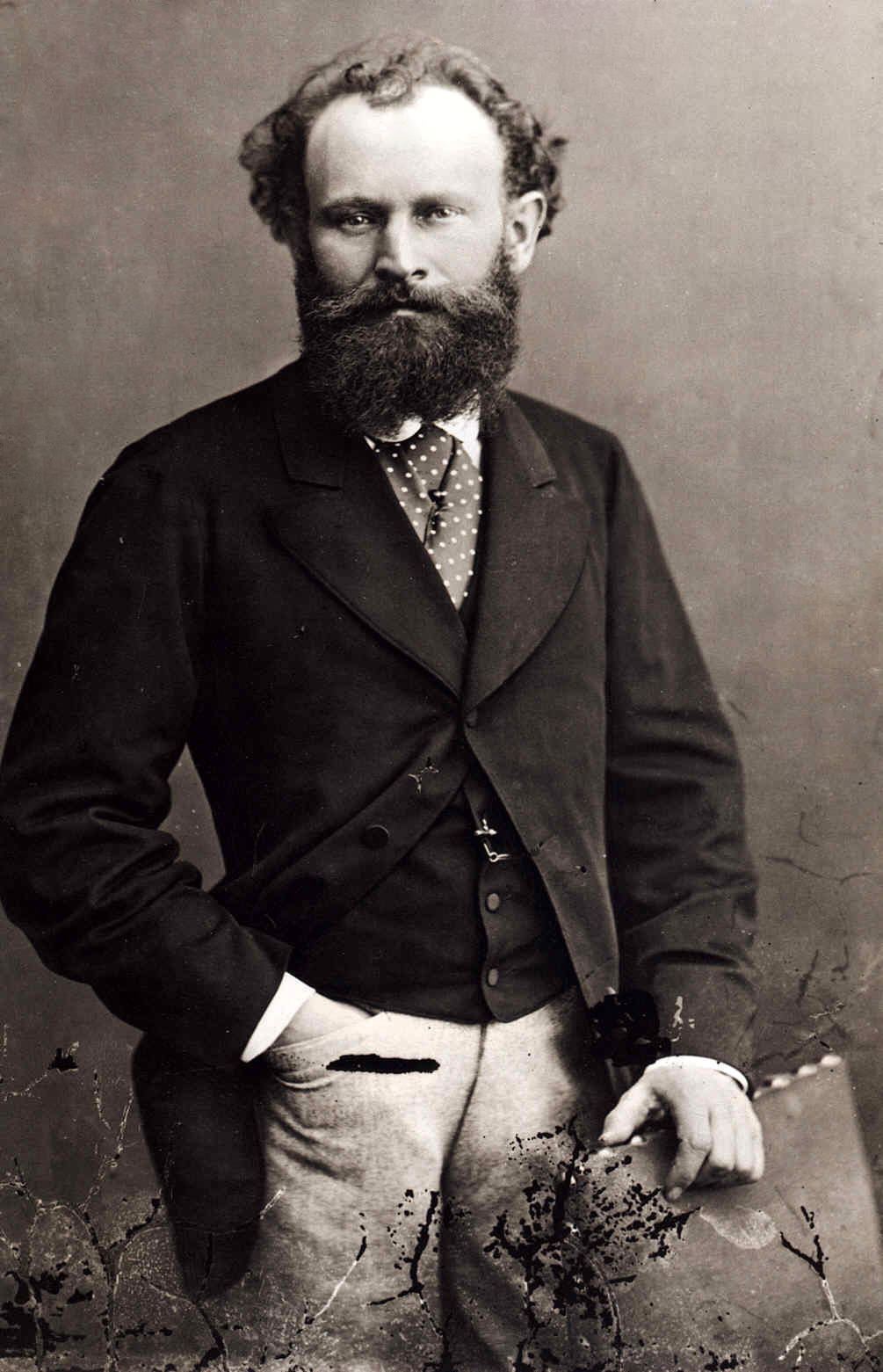 A French
artist, Édouard Manet, introduced a revolutionary method. In The
Dead Toreador
light strikes the figure head on. There are no shadows. Form is
obtained, not with differences of value, but with different patches
of color.
A French
artist, Édouard Manet, introduced a revolutionary method. In The
Dead Toreador
light strikes the figure head on. There are no shadows. Form is
obtained, not with differences of value, but with different patches
of color.

 This
idea was carried even further by artists such as Claude Monet, who
painted Sunflowers.
Monet developed what is called “broken color” painting; that is,
he painted objects by means of brush strokes of various colors placed
next to each other. Instead of mixing colors together on a palette,
as artists had done for centuries, Monet and his followers put the
color strokes on separately and let the eye of the observer mix them.
Such paintings have a wonderful vitality and sense of light. The
technique that attempts to convey the transient effects of direct and
reflected sunlight is known as impressionism.
This
idea was carried even further by artists such as Claude Monet, who
painted Sunflowers.
Monet developed what is called “broken color” painting; that is,
he painted objects by means of brush strokes of various colors placed
next to each other. Instead of mixing colors together on a palette,
as artists had done for centuries, Monet and his followers put the
color strokes on separately and let the eye of the observer mix them.
Such paintings have a wonderful vitality and sense of light. The
technique that attempts to convey the transient effects of direct and
reflected sunlight is known as impressionism.
The
word derives from a painting exhibited by Monet in 1874, entitled
Impression:
Sunrise.
The picture was greeted with public derision, the like of which had
never been experienced in Paris. Every tradition of European painting
seemed to have been thrown aside. Not only form but substance itself
has v anished.
To the Parisians the picture looked like a mere collection of
coloured streaks and blobs on a light blue ground. Today observers
have hardly any difficulty in recognising a sailboat and a rowboat in
the foreground, masts and equipment, haze and smoke, all reflected in
the rippled surface of the water. This revolutionary painting aimed
to reproduce the image the eye sees in an instantaneous glimpse of
the port of Le Havre at sunrise.
anished.
To the Parisians the picture looked like a mere collection of
coloured streaks and blobs on a light blue ground. Today observers
have hardly any difficulty in recognising a sailboat and a rowboat in
the foreground, masts and equipment, haze and smoke, all reflected in
the rippled surface of the water. This revolutionary painting aimed
to reproduce the image the eye sees in an instantaneous glimpse of
the port of Le Havre at sunrise.
Long before the French artists of the XIX century, Constable and Turner had suggested the use of paint to convey light. But not until the impressionists had the artists reproduced fleeting atmospheric effects so accurately.

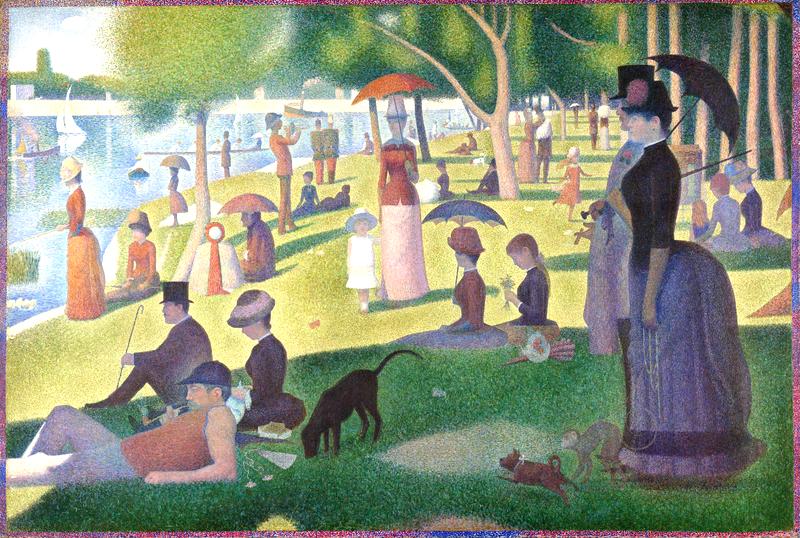 Georges
Seurat, who is considered a postimpressionist, used the idea of
broken color to develop a very characteristic style called
pointillism. He painted entirely by means of dots of pure color. The
most subtle ranges in form and color could be shown by changing the
combination of colors of the dots. This was a very controlled way of
painting, and the compositions of his pictures are entirely in
keeping with the great care required by the method. The painting
Sunday
Afternoon on the Island of the Grande Jatte
is a view of a gay holiday crowd on an island near Paris. The careful
composition gives the effect of great stability, which is in curious
contrast to the lively effect of the dots of paint. It has a feeling
of rightness and even truthfulness that make it one of the greatest
of modern pictures.
Georges
Seurat, who is considered a postimpressionist, used the idea of
broken color to develop a very characteristic style called
pointillism. He painted entirely by means of dots of pure color. The
most subtle ranges in form and color could be shown by changing the
combination of colors of the dots. This was a very controlled way of
painting, and the compositions of his pictures are entirely in
keeping with the great care required by the method. The painting
Sunday
Afternoon on the Island of the Grande Jatte
is a view of a gay holiday crowd on an island near Paris. The careful
composition gives the effect of great stability, which is in curious
contrast to the lively effect of the dots of paint. It has a feeling
of rightness and even truthfulness that make it one of the greatest
of modern pictures.
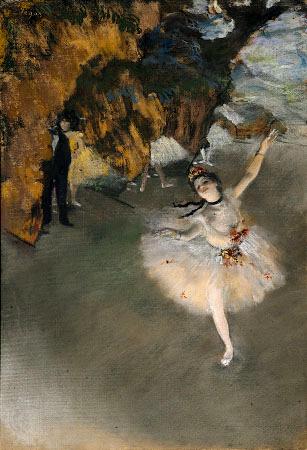
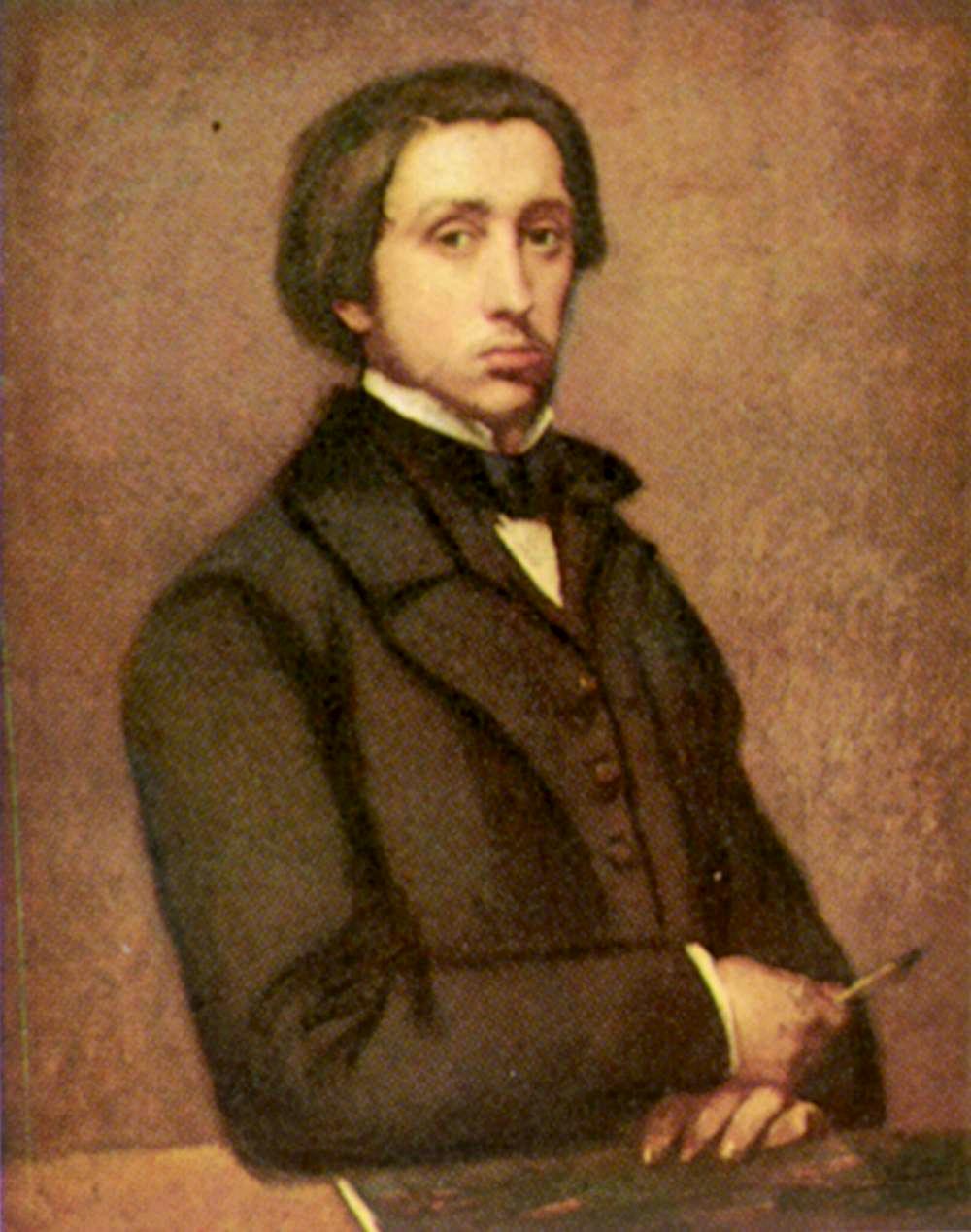 In the
1860s an exhibition in Paris of Japanese prints greatly interested
the impressionists. They were seeking new subject matter and new
color schemes, a fresh point of view, the unexpected and the
original. All these they found in the work of the Orient. Edgar Degas
was one of the impressionists who found inspiration in Japanese art.
In the
1860s an exhibition in Paris of Japanese prints greatly interested
the impressionists. They were seeking new subject matter and new
color schemes, a fresh point of view, the unexpected and the
original. All these they found in the work of the Orient. Edgar Degas
was one of the impressionists who found inspiration in Japanese art.
He was particularly interested in showing rhythmic movement from unusual angles. In Prima Ballerina, the point of view is high, as though the artist were looking down from a box above the stage.
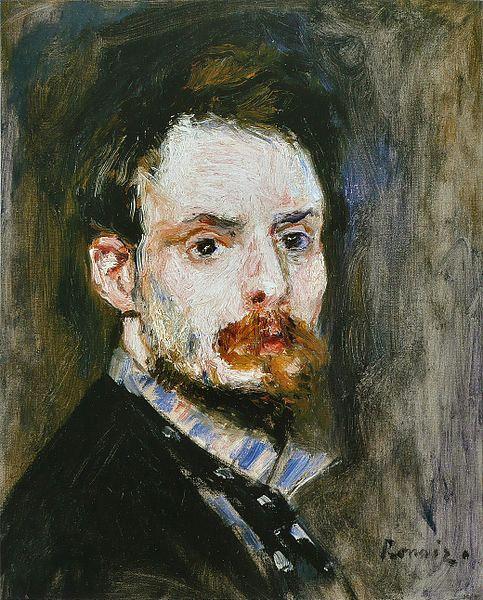
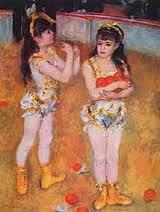 Pierre-Auguste
Renoir was another of the important French artists who helped develop
impressionism, though he later preferred a more formal style. His use
of warm colors and rounded figures is evident in his Two
Little Circus Girls.
Pierre-Auguste
Renoir was another of the important French artists who helped develop
impressionism, though he later preferred a more formal style. His use
of warm colors and rounded figures is evident in his Two
Little Circus Girls.
Illustrations: 1. Félix Nadar, Édouard Manet (1874), photo; 2. Manet, The Dead Toreador (1864); 3. Félix Nadar, Claude Monet (1899) photo; 4. Monet, Sunflowers (1881); 5. Georges Seurat (1888) photo; 6. Seurat, Sunday Afternoon on the Island of the Grande Jatte (1884–1886); 7. Degas, Self-portrait (1855); 8. Degas, Prima Ballerina (1876-1878); 9. Renoir, Self-portrait (1875); 10. Renoir Two Little Circus Girls (1879).
TASKS:
I. Give Russian equivalents of the following:
the amount of light and dark in a color; light and shade; to introduce a revolutionary method; light strikes the figure head on; to obtain a form (with smth); a patch of color; to carry an idea even further; to develop a style of / in / painting; to place smth and smth else next to each other; smb's follower; the eye of the observer; direct and reflected sunlight; a painting entitled … ; rippled surface of the water; to be considered (a postimpressionist or smth else); a controlled way of painting; to be entirely in keeping with smth; the method requires great care; the most subtle range in form and color; the careful composition has a feeling of rightness and even truthfulness; to seek smth; subject matter; color scheme; the unexpected and the original; to show smth from (some) angle; as though smb were doing smth; a box above the stage; smb's characteristic features of style are evident in this particular picture.
II. Give English equivalents of the following:
валёр (соотношение тонов цвета); достигать трёхмерного эффекта посредством моделирования; то есть; рядом с (чем-л); вместо (чего-л); смешивать краски на палитре; пытаться сделать что-л; передать (на холсте) что-л; что-л известно как что-л ещё; слово происходит от … ; никогда до (кого-л) (кто-л ещё) не делал что-л; посредством чего-л (3 варианта); согласовываться (гармонировать) с чем-л; кто-л считается постимпрессионистом; широчайший диапазон форм и цвета (диапазон едва уловимых очертаний и оттенков); производить впечатление (чего-л); тема / тематика; цветовая гамма (решение); Восток; находить вдохновение в чём-л; интересоваться чем-л;
III. Match the words on the right with their antonyms on the left:
1. light (a) A. same
2. revolutionary B. lifelessness
3. various C. after
4. next to D. at variance with
5. vitality E. dark
6. transient F. dull
7. until G. permanent
8. care (n) H. the Occident
9. in keeping with I. apart from
10. lively J. conventional
11. the Orient K. negligence
